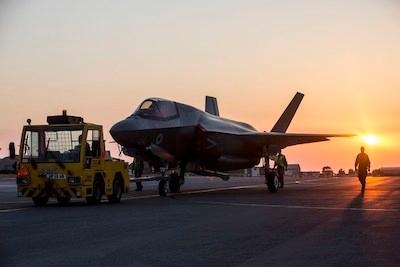Sun, Jan 21, 2024
Improper Procedural Adherence, Rushed Equipment Checks, Clunky Interfaces Blamed for Ruined Engine
A team in the 62nd Aircraft Maintenance Unit at Luke AFB slipped up while executing a Time Compliance Technical Directive for an F-35A aircraft, allowing a ground-run engine to ingest a handheld flashlight.

The error "damaged the $14,000,000 engine beyond local repair" according to the investigative report, though the replacement parts required should be a comparably cheaper $3,900,000. The maintenance was intended to install a metering plug as required after an F-35B mishap in December of 2022.
"To complete the TCTD, the team removed a panel and inserted a metering plug into an engine fuel line. They prepared the aircraft for an engine run to test the installed metering plug for fuel leaks. The engine run was completed with no visual indications or health reporting codes that would indicate an abnormal engine run. Once the engine was shut down, the MT reported hearing a noise from the decelerating engine. A post-engine run inspection was completed by mishap member 1. The inspection noted significant damage to the engine."
"The Board President found by a preponderance of evidence that a handheld flashlight caused the damage to the aircraft. An incomplete tool kit inventory and failure to comply with Joint-Service Technical Data guidance, prior to engine start, resulted in the FOD. The Board President found that F-35 Autonomic Logistics Information System checklist complacency and a disconnect between Department of the Air Force Instruction 21-101 tool inventory guidance and unofficial local procedures were contributing factors to the mishap."
Riding along with the narrative is a nod to the difficult interface and worry layout of the ALIS maintenance system. That “Autonomic Logistics Information System” sounds great in theory, but the personnel on the ground always find the easiest way around an obtuse system. The investigation notes that the Portable Maintenance Aids used to guide the installation are “not optimized to conduct flightline maintenance”, since the ALIS suite was designed as a whole-aircraft diagnostics and logistics ecosystem. In practice, a lack of network connectivity on the flightline means teams have to run back and forth to a networked building to update their electronics and forms. That post-hoc documentation leads to complacency, since logging is done long after the job is complete, and correct procedure is assumed after the fact.
On top of that, the electronics inhibit easy flightline maintenance with a byzantine workflow. The checklist used in the botched installation was only one of many required to be referenced - in total 15 discrete checklists were needed for reference. The need to scan and scroll through a mountain of data also causes complacency, according to the investigation. Luckily for the teams, ALIS will one day be replaced by ODIN. That unit replaces the 800-lb ALIS computer with 100 lbs of processing power…but no word has really been said in regards to workflow improvements.
More News
Aero Linx: International Federation of Airworthiness (IFA) We aim to be the most internationally respected independent authority on the subject of Airworthiness. IFA uniquely combi>[...]
Ultrahigh Frequency (UHF) The frequency band between 300 and 3,000 MHz. The bank of radio frequencies used for military air/ground voice communications. In some instances this may >[...]
A Few Questions AND Answers To Help You Get MORE Out of ANN! 1) I forgot my password. How do I find it? 1) Easy... click here and give us your e-mail address--we'll send it to you >[...]
From 2019 (YouTube Edition): Learning To Paint Without Getting Any On Your Hands PPG's Aerospace Coatings Academy is a tool designed to teach everything one needs to know about all>[...]
Also: Sustainable Aircraft Test Put Aside, More Falcon 9 Ops, Wyoming ANG Rescue, Oreo Cookie Into Orbit Joby Aviation has reason to celebrate, recently completing its first full t>[...]
 ANN's Daily Aero-Linx (05.06.25)
ANN's Daily Aero-Linx (05.06.25) ANN's Daily Aero-Term (05.06.25): Ultrahigh Frequency (UHF)
ANN's Daily Aero-Term (05.06.25): Ultrahigh Frequency (UHF) ANN FAQ: Q&A 101
ANN FAQ: Q&A 101 Classic Aero-TV: Virtual Reality Painting--PPG Leverages Technology for Training
Classic Aero-TV: Virtual Reality Painting--PPG Leverages Technology for Training Airborne 05.02.25: Joby Crewed Milestone, Diamond Club, Canadian Pilot Insurance
Airborne 05.02.25: Joby Crewed Milestone, Diamond Club, Canadian Pilot Insurance



